Sony is among the last among camera manufacturers which disguises and/or restricts framerates. Sony even treats camera purchasers who spend less than ≈US$5k differently than those who spend more, since cameras under about that amount unfortunately round non-integer rates in menus to the closest integer in menus and display, implying that they offer exact 24 fps when they don’t in these models. Fortunately, cameras like Blackmagic, some Canon, Panasonic and at least one Sigma now show non-integer rates to two decimals and offer both 23.976 (displayed as 23.98) in addition to exact 24 in models well under US$5k, since there are times when producers need one or the other. Despite naysayers and Internet trolls, the difference indeed matters. Even though I have explained this difference in the past, I’ll recap it and give you examples to indicate when one of the two is required. I’ll also clarify why the exact 30 fps rate disappeared in 1953 and was superseded by 29.97. I’ll quote a user who has publicly expressed his frustration with Sony about this situation.
In this article:
- Sony framerates and limitations in menus
- How Canon, Panasonic Lumix and Sigma handle framerates
- And Blackmagic?
- A user who suffers from Sony’s restrictions and lack of transparency
- Solutions and Conclusions
Sony framerates and limitations in menus
From my observations, under about US$5k, Sony still rounds all non-integer framerates to the closest integer and imposes other limitations as follows:
- 23.976 fps is sadly rounded to “24” in many Sony cameras under ≈US$5k menus (which deceives many innocent users into thinking that those cameras are recording at exact 24 fps, which is not the case).The 23.976 fps rate is filmic looking yet fits with those broadcasters that exist in ex-NTSC broadcast regions. The 23.976 fps rate is also useful elsewhere, including DVD, Blu-ray and the web.
- The true, exact 24 fps rate is sadly not available in these under ≈US$5k Sony cameras (despite insinuations to the contrary due to rounding), even though the exact 24 rate is required for DCI digital theaters and Riverside.fm, as well as working online, especially older AppleTV boxes and a minority of Blu-ray disks.
- 25 fps is displayed properly as 25 in these Sony cameras and is required for consistent cadence with Zoom.us per this article, Argentine, Australian, European, Paraguayan and Uruguayan broadcasters. The 25 fps rate is also fine for the web.
- 29.97 is sadly rounded to 30 in these Sony cameras. (The exact 30 fps rate disappeared in 1953, when the United States added color to the previous grayscale/monochrome system. Some innocent users actually believe they are recording at exactly 30 fps and even set their project settings as such in their editing software, which obliges an unnecessary and damaging conversion to a rate no longer accepted by TV stations in NTSC or ex NTSC regions.)
- 50 fps is displayed properly as 50 and is ideal for certain Argentine, Australian, European, Paraguayan and Uruguayan broadcasters, especially 720p sports channels in those regions or for the web, as long as your viewers’ devices can play 50 Hz.
- 59.94 fps is sadly rounded to 60 in these Sony camera menus (which deceives many innocent users into thinking that those cameras are recording at exact 60, which is not the case). The 59.94 fps rate is ideal for 720p sports channels like ESPN and other 720p channels as I covered here or for the web, as long as your viewers’ devices can play 59.94 Hz.
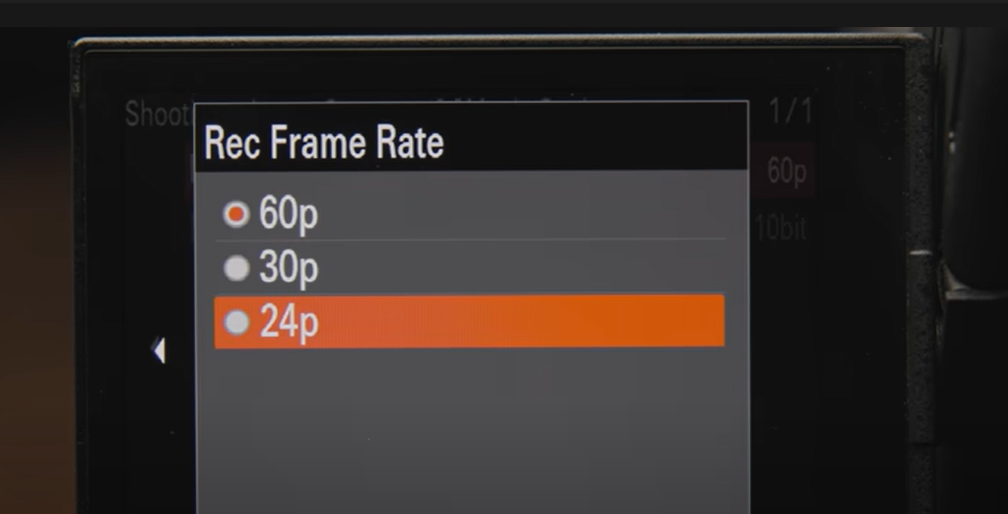
The above screenshot (courtesy of this video from Potato Jet) shows Sony framerate options for NTSC-derived regions with Sony cameras under US$5k. Remember, with these cameras, when Sony says “60”, it really means 59.94. When Sony says “30”, it really means 29.97. And when Sony says “24”, it really means 23.976.
Please note that with some Sony camera models, changing from the NTSC-derived mode to the PAL-derived mode will require rebooting the camera and in some cases will also format (erase) the memory card. So if your Sony camera does this and you must shoot among both, be sure to have memory cards reserved for each mode and remove the current memory card before shifting. After changing to the PAL-derived mode, the rates shown (25, 50 and possibly more) will be proper integers since PAL fortunately never had to resort to non-integer rates.
How Canon, Panasonic Lumix and Sigma handle framerates
Some Canon, nearly all Panasonic Lumix and at least one Sigma well under US$5k fortunately offer all standard rates without rounding to the closest integer in the menus:
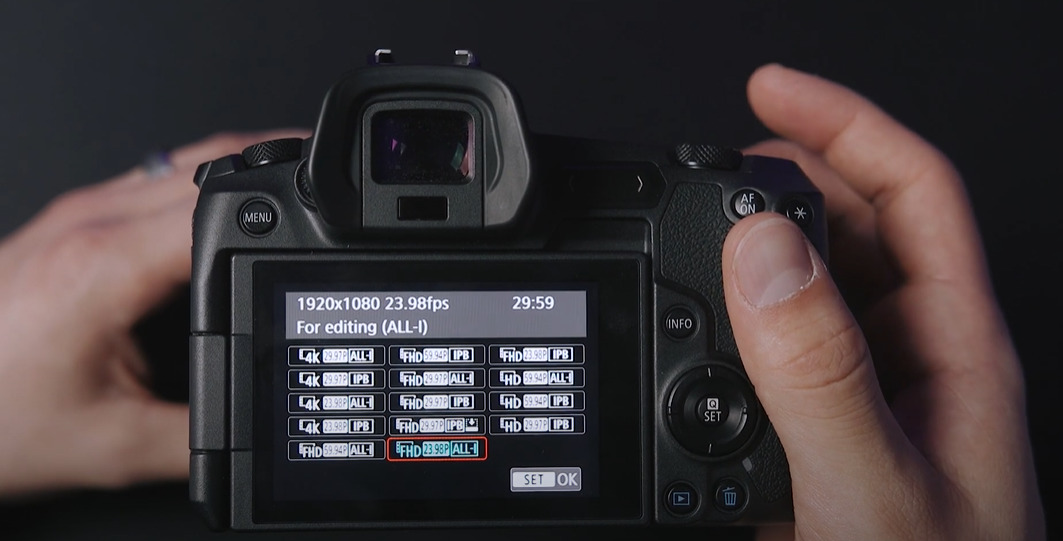
Above, you’ll see how the Canon EOS R shows 23.976 in the menu, rounded to 23.98 but fortunately not to “24”. That frame grab is courtesy of Tyler Herrinton’s video here. On the other hand, below you will see that the same Canon EOS R offers exact 24, thanks to this screenshot courtesy of Chris Spiegl’s video here:
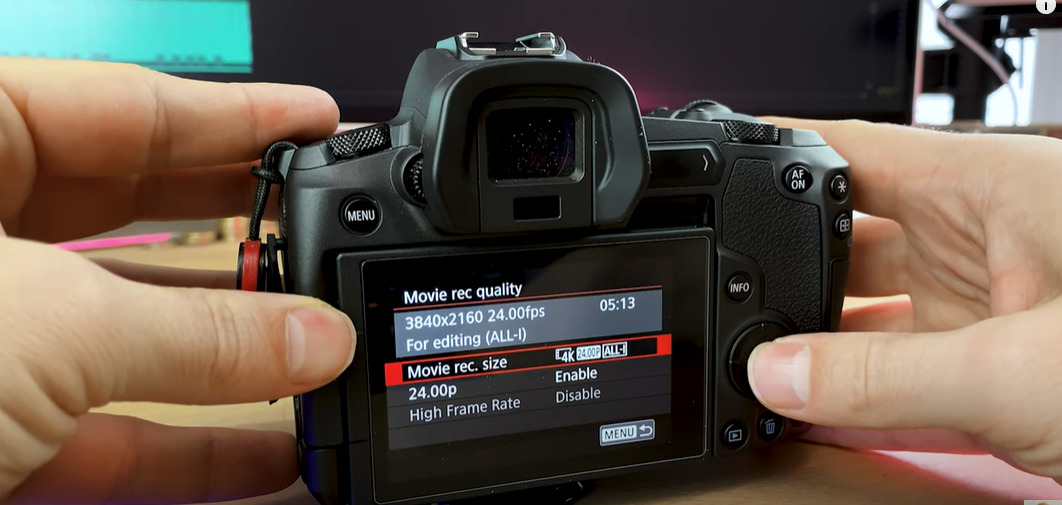
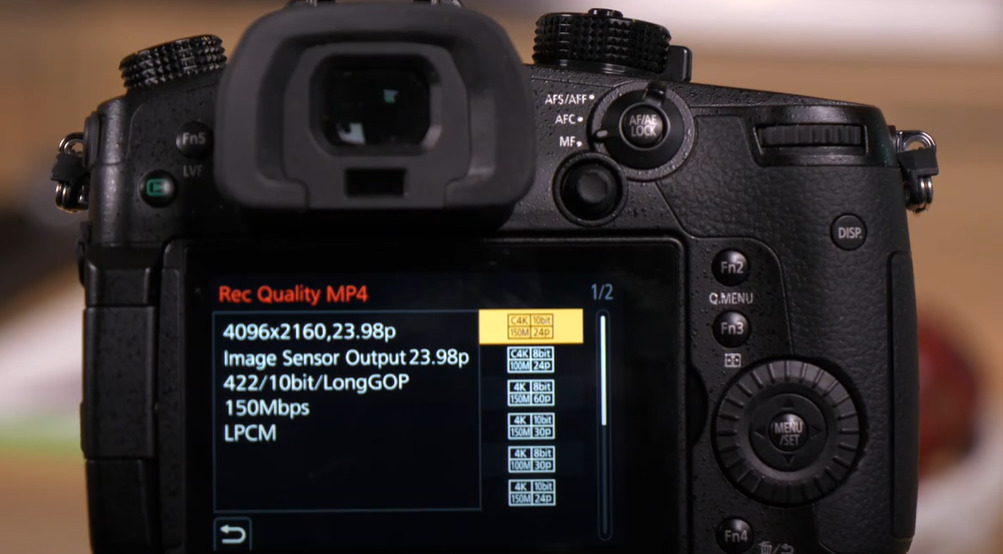 Above, you’ll see how the Panasonic Lumix shows 23.976 in the menu, rounded to 23.98 but fortunately not to “24”. This screenshot is courtesy of Panasonic’s own video here.
Above, you’ll see how the Panasonic Lumix shows 23.976 in the menu, rounded to 23.98 but fortunately not to “24”. This screenshot is courtesy of Panasonic’s own video here.
- 23.976 fps (rounded to 23.98 in camera menus in some cases, but fortunately not rounded to “24”, gives us a filmic-ish rate compatible with broadcast television in NTSC or ex NTSC broadcast regions, DVDs, many Blu-ray disks… or the web)
- 24 exact is indeed available in many cameras and is required for DCI digital theaters and Riverside.fm, as well as working online, especially older AppleTV boxes and a minority of Blu-ray disks.
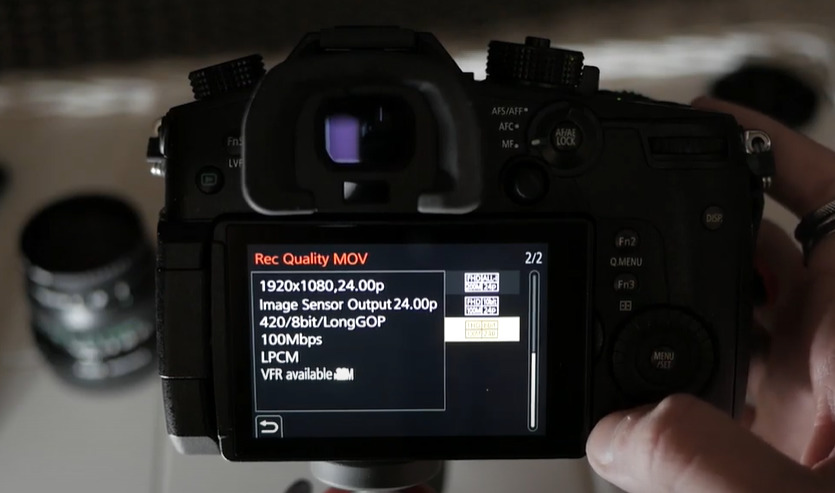
After the Panasonic Lumix’s System Frequency is set to 24 Hz, then it indeed offers 24.00 fps and really means it, without any rounding. This frame grab is courtesy of JustAlex Himself’s video here.
Sigma makes it even simpler:
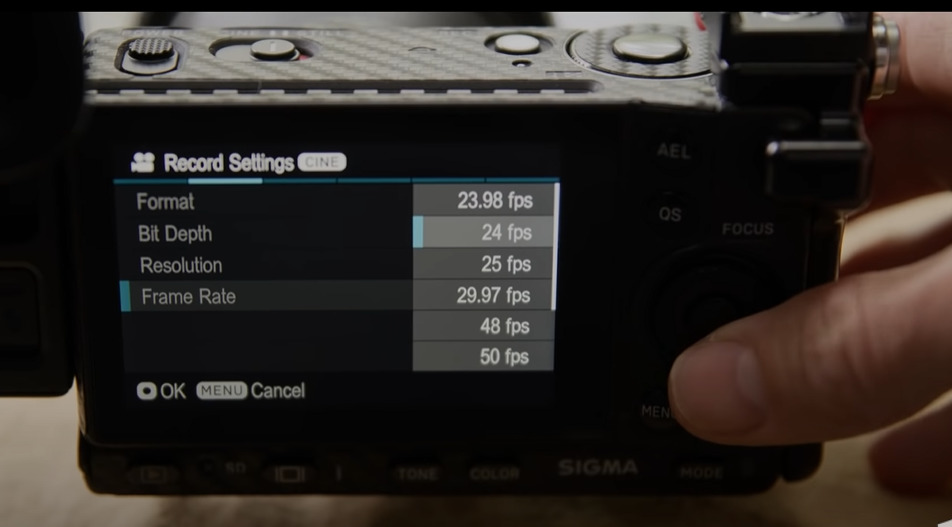 Unlike Canon, Panasonic Lumix or Sony, the Sigma FP can cover all the rates without having to switch the clock first, let alone reformat the memory card. This screenshot is courtesy of this video from Justin Philup.
Unlike Canon, Panasonic Lumix or Sony, the Sigma FP can cover all the rates without having to switch the clock first, let alone reformat the memory card. This screenshot is courtesy of this video from Justin Philup.
- 25 fps is available and is required for consistent cadence with Zoom.us per this article, Argentine, Australian, European, Paraguayan and Uruguayan broadcasters. The 25 fps rate is also fine for the web.
- 29.97 fps (ideal for NTSC or ex NTSC television stations or the web)
- 50 fps (ideal for Argentine, Australian, European, Paraguayan and Uruguayan broadcasters, especially 720p sports channels in those regions or for the web, as long as your viewers’ devices can play 50 Hz.)
- 59.94 fps (ideal for 720p sports channels like ESPN and other 720p channels as I covered here or for the web, as long as your viewers’ devices can play 59.94 Hz.)
And Blackmagic?
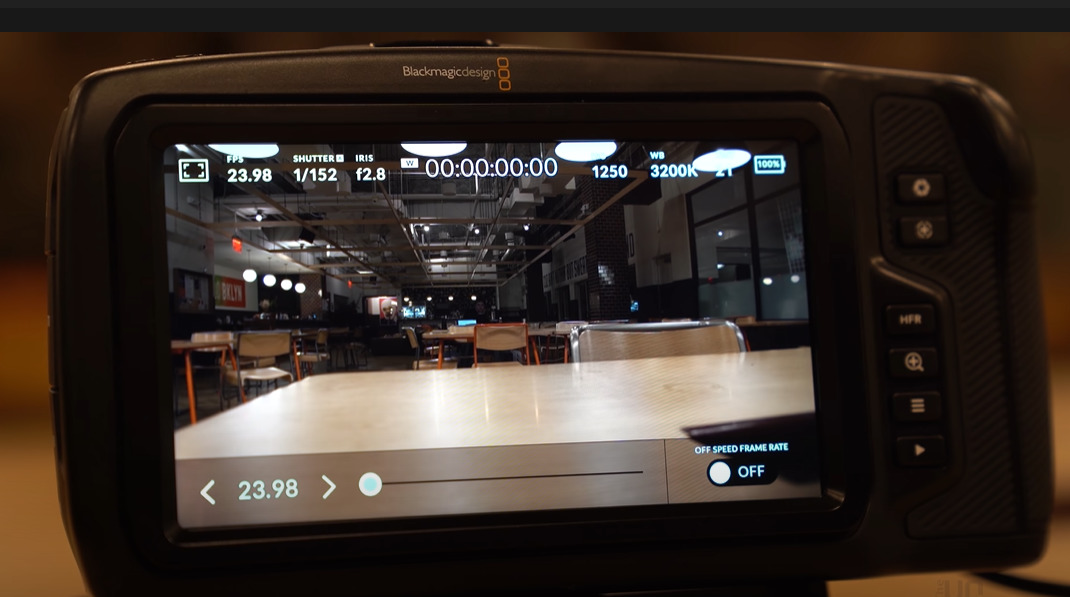
Above you’ll see Blackmagic show the 23.976 fps rate as 23.98 (but fortunately not rounded to “24”). Below, you’ll see Blackmagic at exact 24. Both screenshots are courtesy of this video from TheUnlockr. Like the Sigma FP, Blackmagic cameras are able to switch among all framerates without having to switch the system clock in a separate menu and without having to reboot.
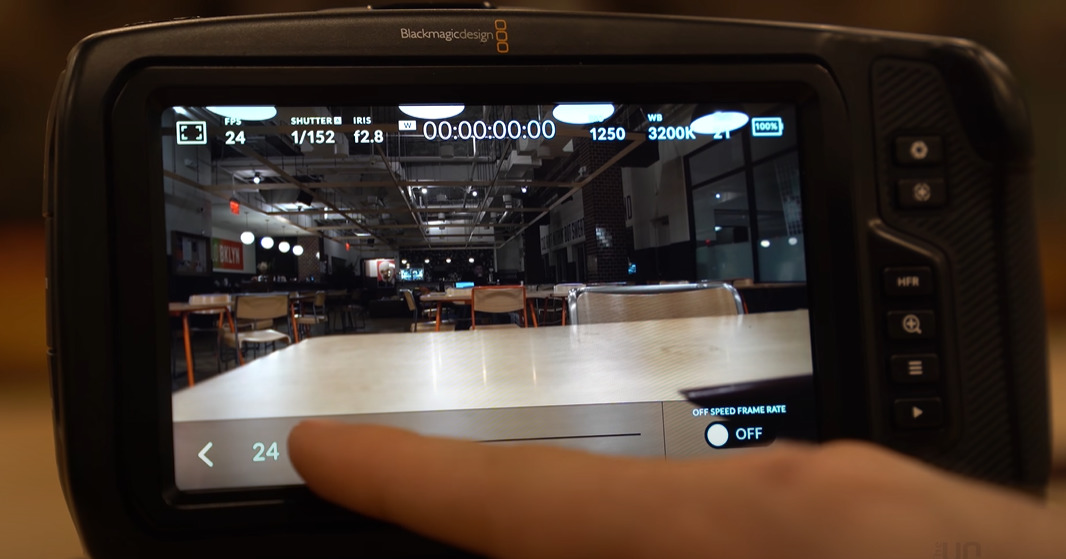
Blackmagic cameras have all of the rates offered by Canon, Panasonic Lumix and Sigma as indicated in the prior section plus (in some cameras, but not all) the now non-standard exact 30 and exact 60 fps (non-standard for broadcast since before 1953). Of course, I know that exact 60 fps has become a standard for gamers (likely due to a misunderstanding caused by some innocent engineer who read a 59.94 spec which was deceptively rounded to “60”). Why does Blackmagic offer these two non-standard rates in addition to the standard ones? I speculate that Blackmagic offers exact 60 fps for gamers and just in case someone needs to create video and later time-travel to before 1953. Of course, that would be grayscale (monochrome), where the camera is set to image exact 60 fps and then the image is converted to exactly 30 interlaced frames per second with exactly 60 fields per second. The image would also need to be center cut to be 4:3 or letterboxed. Now only if the time travel part were that easy…
A user who suffers from Sony’s restrictions and lack of transparency
An individual named Ayawolf (whom I don’t know personally) posted the the following question on the DPreview forum:
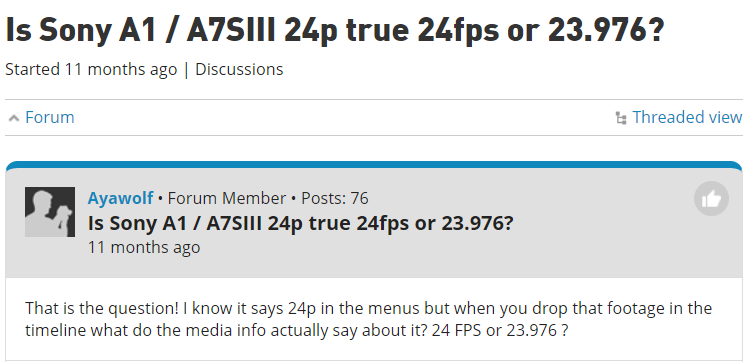
Is Sony A1 / A7SIII 24p true 24fps or 23.976?
Given the sad reality that the Internet is full of trolls and naysayers (in addition to many good people too), Ayawolf’s first response was nasty and attempted to belittle his important question:
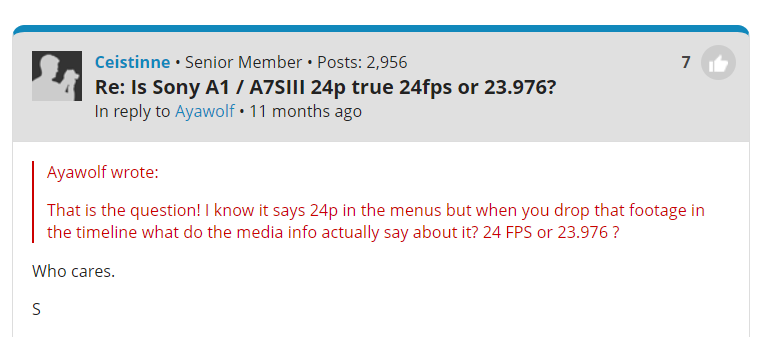
Who cares?
Of course, if you have read the rest of this article up until now, you already know the answer. In fact, later in that thread, someone informs Ayawolf that the supposed “24” in this camera is actually 23.976 as read in the metadata in a professional software app, and Ayawolf really needed the exact 24 fps for her/his particular situation.
Solutions and Conclusions
Other than this cruel framerate policy, Sony manufactures great cameras. It is sad that —so far— Sony has been crippling itself with limitations and lack of transparency regarding framerates. Of course, it is possible to convert 23.976 fps to 24 fps or 24 fps to 23.976 fps in post. However, that is time consuming and much more complicated. Everything is smoother when cameras actually disclose what they can truly deliver… and when they offer all desired rates (when the hardware allows), the way Sony’s competitors have been doing for a long time in many of their cameras in the same price bracket. In the past, Sony has taken our voice into account and added capabilities via a firmware update. Let’s hope that happens again. If and when Sony offers a firmware update to solve this mess, I’ll certainly write about it to celebrate, as I have done in the past.
Related articles
- Video streaming in the era of framerate wars
- Filmmaker Mode in newer UHD TV sets/monitors guarantees matching cadence/framerate and more
(Re-)Subscribe for upcoming articles, reviews, radio shows, books and seminars/webinars
Stand by for upcoming articles, reviews, books and courses by subscribing to my bulletins.
In English:
- Email bulletins, bulletins.AllanTepper.com
- In Telegram, t.me/TecnoTurBulletins
- Twitter (bilingual), AllanLTepper
En castellano:
- Boletines por correo electrónico, boletines.AllanTepper.com
- En Telegram, t.me/boletinesdeAllan
- Twitter (bilingüe), AllanLTepper
Most of my current books are at books.AllanTepper.com, and also visit AllanTepper.com and radio.AllanTepper.com.
FTC disclosure
Some of the manufacturers listed above have contracted Tépper and/or TecnoTur LLC to carry out consulting and/or translations/localizations/transcreations. Many of the above manufacturers have sent review units to Allan Tépper so he can do his reviews. So far, none of the manufacturers listed above is/are sponsors of the TecnoTur, BeyondPodcasting, CapicúaFM or TuSaludSecreta programs, although they are welcome to do so, and some are, may be (or may have been) sponsors of ProVideo Coalition magazine. Some links to third parties listed in this article and/or on this web page may indirectly benefit TecnoTur LLC via affiliate programs. Allan Tépper’s opinions are his own. Allan Tépper is not liable for misuse or misunderstanding of information he shares.

Filmtools
Filmmakers go-to destination for pre-production, production & post production equipment!
Shop Now












